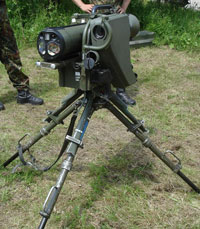MILAN
(French: Missile d´infanterie léger antichar; English translation:
Anti-Tank Light Infantry Missile) is a European anti-tank guided
missile.
Design of the MILAN started in 1962. It was ready for trials
in 1971, and was accepted for service in 1972.
It is a wire guided SACLOS (Semi-Automatic Command to Line-Of-Sight) missile, which means
the sight of the launch unit has to be aimed at the target to guide
the missile. The MILAN can be equipped with a MIRA thermal sight, to
give it night-firing ability.
Milan II is a second generation anti-tank weapon, the result of a
joint development project between France and West Germany.
The Milan comes in two main portable components, which are the
launcher and the missile. It is a simple matter to clip both items
together and prepare the system for use. On firing, the operator has
only to keep his aiming mark on the target and the SACLOS guidance
system will do the rest.
Milan was the first of a series of infantry anti-tank weapons that
seriously started to challenge the supremacy of the main battle tank
on the battlefield. During fighting in Chad in 1987, it appears that
12 Chadian Milan, post mounted on Toyota Light Trucks, were able to
account for over 60 Libyan T-55s and T-62s. Reports from other
conflicts suggest similar results.
In addition to being capable of defeating main battle tanks (MBTs)
from all aspects, Milan is also required to have a secondary
capability against other battlefield targets, such as fixed defences.
|
MILAN II Specifications |
|
Type |
Man portable
anti-tank missile |
|
Manufacturer |
Lockheed Martin, Raytheon |
|
Weight |
28kg |
|
Warhead |
8.4kg tandem shaped HEAT capable of penetrating up to 600mm
of armour |
|
Length |
1.1m |
|
Diameter |
12.7m |
|
Performance |
Range 75m - 2km, guidance
infrared |

